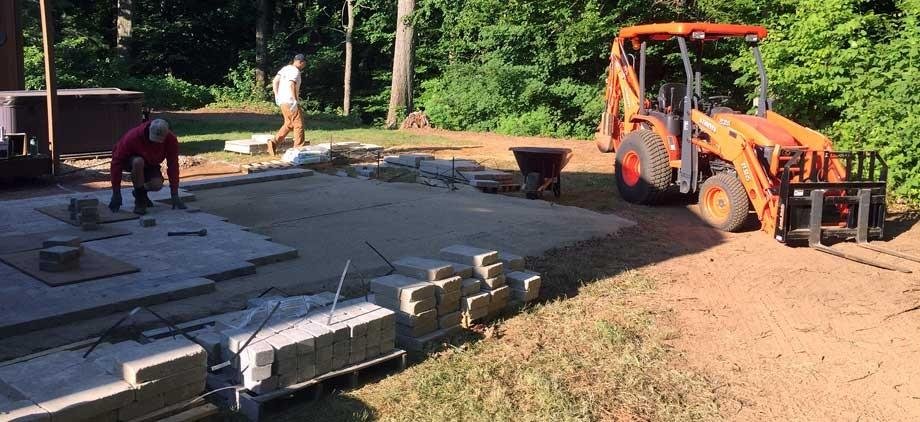Landscaping plays a pivotal role in enhancing construction projects, adding value, functionality, and aesthetic appeal to new buildings and renovations. Integrating landscaping effectively can transform a construction site into a beautiful and inviting environment. Here’s how landscaping enhances construction projects.
1. Boosts Curb Appeal
Visual Impact
First impressions matter, and well-planned landscaping significantly boosts a property’s curb appeal. Attractive gardens, neatly manicured lawns, and thoughtfully designed pathways can make a building look more inviting and well-maintained.
Architectural Harmony
Landscaping that complements the architectural style of a building creates a cohesive look. Matching plants, materials, and colors with the construction design enhances the overall aesthetic and reinforces the property’s character.
2. Increases Property Value
Investment Return
High-quality landscaping can increase the market value of a property. Studies show that well-landscaped homes sell for more than those without landscaping, making it a valuable investment for property owners.
Long-Term Benefits
Investing in landscaping during construction not only adds immediate value but also provides long-term benefits. Mature plants and well-established landscapes enhance property appeal over time, attracting potential buyers or tenants.
3. Improves Functionality
Outdoor Living Spaces
Incorporating landscaping can create functional outdoor living spaces, such as patios, decks, and gardens. These areas provide opportunities for relaxation, entertainment, and outdoor activities, enhancing the overall usability of the property.
Accessibility and Flow
Thoughtful landscape design ensures smooth accessibility and flow between different areas of the property. Pathways, seating areas, and landscaping features can guide visitors and create inviting transitions between indoor and outdoor spaces.
4. Enhances Environmental Sustainability
Eco-Friendly Practices
Integrating landscaping into construction projects allows for the use of eco-friendly practices, such as selecting native plants that require less water and maintenance. Sustainable landscaping practices can improve biodiversity and reduce the environmental footprint of the property.
Stormwater Management
Well-designed landscapes can help manage stormwater runoff, reducing erosion and water pooling. Incorporating features like rain gardens, permeable paving, and bioswales not only enhances the landscape but also contributes to sustainable water management.
5. Provides Shade and Comfort
Climate Control
Strategically placed trees and plants can provide shade, helping to cool outdoor areas and reduce energy costs for buildings. Proper landscaping can create comfortable microclimates, making outdoor spaces more enjoyable.
Outdoor Comfort
Landscaping elements such as pergolas, trellises, and seating areas can create inviting outdoor spaces for relaxation and gatherings. These features enhance the overall comfort and usability of the property.
6. Attracts Wildlife
Biodiversity
Incorporating diverse plantings and natural elements into landscaping encourages local wildlife, such as birds and butterflies, to thrive. This biodiversity enhances the natural beauty of the property and promotes ecological health.
Educational Opportunities
A well-designed landscape can provide educational opportunities about local flora and fauna, encouraging awareness and appreciation for the environment among residents and visitors.
7. Creates a Sense of Community
Public Spaces
In commercial or multi-family construction projects, landscaping can create communal spaces that foster community interaction. Parks, gardens, and gathering areas enhance social connections among residents or employees.
Aesthetic Appeal in Shared Areas
Well-landscaped shared spaces, such as courtyards or green roofs, contribute to a sense of pride and ownership among users, enhancing the overall experience of the property.
Benefits of Landscaping and Construction Projects:
- Enhanced Aesthetic Appeal
- Improves the visual appeal of your property by combining design and construction elements.
- Creates beautiful outdoor spaces that complement your home’s architecture.
- Increased Property Value
- Well-planned landscaping and construction projects can significantly raise property value.
- Features like patios, retaining walls, and walkways add functional and aesthetic value.
- Improved Outdoor Functionality
- Adds usable outdoor living spaces, such as patios, outdoor kitchens, or entertainment areas.
- Enhances yard functionality with features like retaining walls for soil control and terracing.
- Environmental Benefits
- Landscaping helps with water management, reducing runoff and improving drainage.
- Using eco-friendly materials and practices in construction can lower environmental impact.
- Erosion Control
- Retaining walls and terracing prevent soil erosion and stabilize slopes.
- Proper landscaping ensures soil is properly maintained and supported.
- Energy Efficiency
- Strategic planting of trees and shrubs can reduce heating and cooling costs by providing shade and windbreaks.
- Use of sustainable materials and practices in construction can reduce overall energy consumption.
- Personalized Outdoor Spaces
- Custom landscaping designs and construction projects allow you to tailor your outdoor space to your preferences and needs.
- Add personalized features such as fountains, walkways, decks, and seating areas.
- Improved Air Quality
- Landscaping with plants and trees improves air quality by filtering pollutants.
- Green spaces also reduce the heat island effect, making the surrounding environment cooler and more comfortable.
- Better Drainage Solutions
- Construction elements like French drains or permeable paving improve drainage, preventing water pooling and damage.
- Proper landscaping ensures that water flows away from the home and doesn’t cause foundational issues.
- Outdoor Recreation and Relaxation
- Provides designated spaces for recreation, like play areas for kids or quiet zones for relaxation.
- Well-designed landscapes create serene environments that promote mental well-being.
Conclusion
Landscaping is an essential component that enhances construction projects in various ways. From boosting curb appeal and property value to improving functionality and sustainability, effective landscaping creates harmonious outdoor spaces that enrich the overall environment. By integrating thoughtful landscaping into construction plans, property owners can achieve lasting benefits that elevate their spaces and provide enjoyment for years to come.



More Stories
Represent Hoodie: Fashion is Far More Than
Why Balenciaga’s Triple S Sneakers Are So Popular
Sp5der Hoodie: Fashion is Far More Than Just